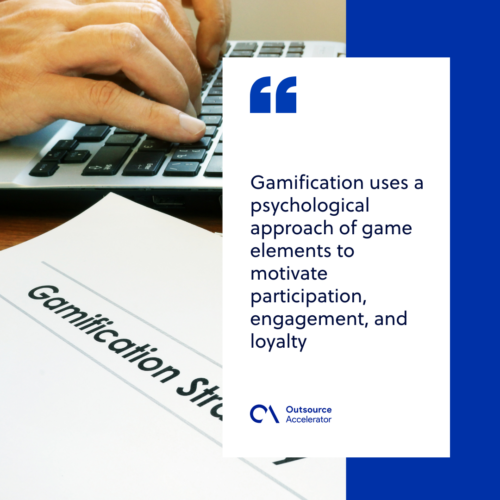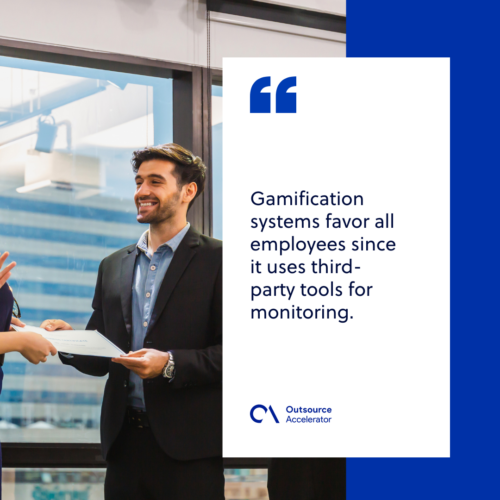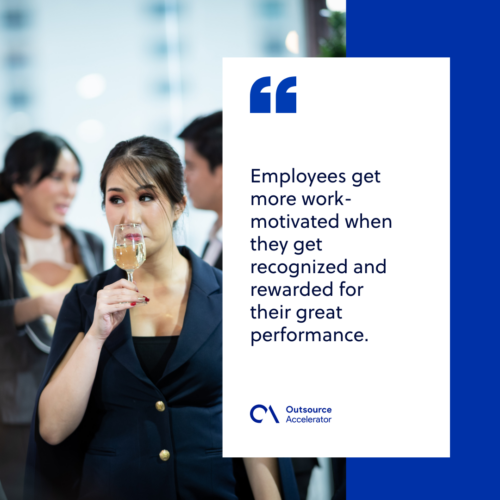Gamification in business

Research shows that employees who are more engaged in company activities stay longer.
This is one of the reasons gamification in the workplace has gained popularity and is highly encouraged, especially with remote teams.
In a recent study by Gartner, 70% of top global companies plan to gamify their workplace for better employee engagement.
Some companies that have already tried it reported an increase in productivity. Workplace gamification inspires employees and makes them enjoy working even more.
However, gamifying incentives may be on a case-to-case basis and may not be suitable for all employees. Some may even find it difficult at first, especially remote employees.
Others may not find this engaging at all. For this, companies should follow several guidelines in gamifying their employees’ incentives.
How gamification in business works
Gamification is applying game mechanics in a business process or workflow. The method uses a psychological approach to game elements to:
- Motivate participation
- Boost user engagement
- Improve employee productivity
Companies develop a set of mechanics for employees to follow and then track their progress using monitoring software. Employers usually apply this method to processes with measurable outputs.
For instance, call centers or business process outsourcing companies use gamification to achieve optimal results within a certain period. Team leaders recognize employees who reached a certain number of calls received and issues resolved in a week.
This usually comes with rewards programs where internal employees with the best results gain award badges, certificates, or additional incentives. These rewards motivate them to give high-quality service to their clients.
Employers also use gamification strategies when training employees or during the onboarding process. HR teams can come up with establishing employee milestones when learning a new skill.
They can organize competitions by giving out quiz bees or incorporating game-like elements into a module and awarding the employee with the highest score.
All these examples of gamification techniques are done with the goal of increasing employee motivation and achieving high business results in an effective and sustainable way.

Benefits of workplace gamification
Gartner noted that in 2015, 40% of Global 1000 had already applied gamification to their processes. These companies mostly use it to help with company transitions.
Gamification has already benefited them in different ways:
- Immediate feedback – Gamification allows employers to boost productivity and increase the engagement of their employees in real-time.
- Less favoritism – Gamification systems favor all employees since they use third-party tools for monitoring. This lessens the possibility of employees getting rewarded and recognized due to favoritism.
- New type of credential – German software company SAP used a point system for the active contributors in the SAP Community Network (SCN). These points determine the ranking of a contributor and are included in their performance reviews and actual employment.

Tips to implement gamification strategies
Most companies who attempted to gamify their workplace before failed for two reasons:
- There was no real employee engagement made
- They were not yet ready to gamify
Employers who want to implement gamification in their business need to plan and study their measures properly.
Here are a few tips to plan your gamification strategy properly:
Study the “players” in the field
Gamification uses a personality-based approach in applying mechanics to a system. To make it effective, employers must study each targeted “player” in the field.
After all, competition drives people to perform at their best, and a motivated workforce heavily influences results.
Analyze what triggers their momentum, how they respond in a situation, and what rewards are suitable for them.
Organize processes
Target a specific area or team to gamify. These can be in marketing campaigns, the sales team, or employee onboarding.
Make sure to organize and streamline processes first to apply the gamification strategy successfully.
Prepare KPIs and success factors to serve as employees’ quotas. Then, set instructions and specific rewards for the targeted team.
Include user experience
Check for tools that can be integrated to track their progress or use existing software personally.
Free tools such as Asana, Slack, and Zoho are some of the best software in the market to use in gamification. Make their progress and statistics accessible for them as part of transparency.
Test it to a selected few
Have a few employees test the gamified system. Gather feedback on improving and making it more “fun” to use. Let them promote the system in the workplace.
Launch and monitor for a few weeks
Try to integrate the system into the workplace and note any improvement in employee performance. Continuously monitor the system and update it when needed.
How to improve employee engagement through gamification
Employees get more work-motivated when they get recognized and rewarded for their great performance. Thus, one of the goals of gamifying is to motivate employees more.
Businesses can prepare several incentives for their employees, such as:
Cash incentives
Cash is a surefire way to motivate people and inspire employees to play. At the end of the week, for instance, each call center agent is measured with either the number of call resolutions in their shift.
The agent with the highest number of calls and ratings for their service is rewarded with a small cash incentive and a certificate.
You can even incorporate a points system, where more points equals more money.
Social events
Employees love social events, particularly concerts and parties. Some businesses give concert tickets or premiere movie passes to their employees as a part of their prizes.
Recognitions
Some teams hold weekly recognition for top agents, complete with awards and certificates. Mostly, this reward comes with either a cash incentive or a gift certificate, depending on the prize allocated to them.
Recreational activities
Lastly, they can win free passes to several recreational activities that are also accessible to them.
Every month, each employee can have consolation prizes for doing a task, and top employees can be qualified for free entrances to a theme park. They can also win gym memberships and movie tickets to help them relax as well.

How to avoid abuse of gamification
While it is true that gamification can drive business performance upward, it also has its downsides.
Employees might show addiction to the game by going to work too early only to reach their weekly goals, sacrificing proper rest and work-life balance.
This may cause burnout and might further negatively affect the performance of employees. Without proper monitoring, they can even “cheat” on their progress just to gain progress.
To avoid these situations, employers should consider these measures to maintain a fair game:
Restrict the quota for each employee
Be realistic with setting objectives and goals of the game-like mechanics. Set a specific quota for each task based on the team’s previous performance.
This helps employers determine if an employee cheats on their statistics and prevents employee burnout.
Give a chance to all team members
Gamification shouldn’t only benefit a few employees. Set milestones to give new employees a chance to be recognized when they reach a specific milestone.
Monitor their performance properly
Use screen monitoring software to monitor your employees’ actual performance. Set random screenshots of their desktops as a reference whenever an issue or suspicious activity arises.
Think of new ways to improve the game
Lastly, as time flies, the game mechanics applied to a task might get boring and hackable to the players.
Regularly improve and update the gamification elements by thinking of new ways to execute them to maintain and improve employee engagement.







 Independent
Independent




